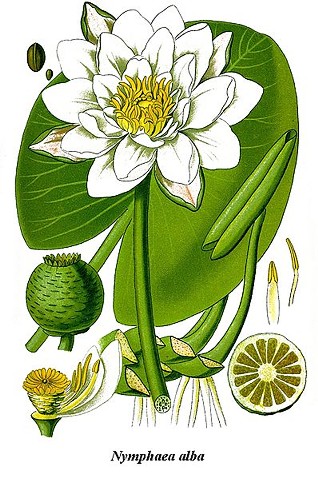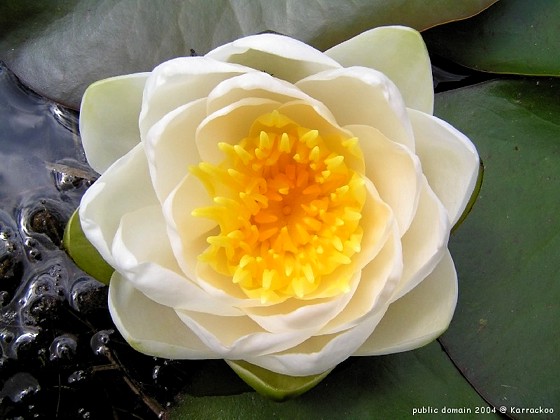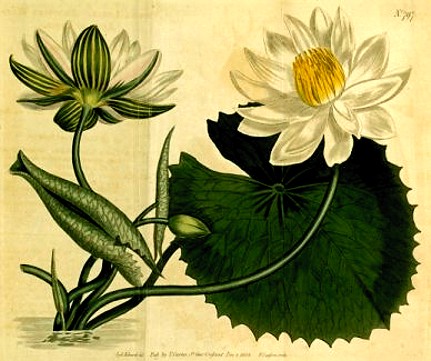Lessico
Ninfea

La pianta delle ninfe, gli spiriti femminili che popolano i luoghi naturali, cioè non abitati né coltivati. Nymphaea: genere di piante acquatiche della famiglia Ninfeacee frequenti negli stagni e laghi delle zone temperate e subtropicali, molto coltivate a scopo ornamentale. Sono erbe perenni rizomatose, con foglie tutte basali lungamente picciolate, galleggianti, ampie, più o meno orbicolari. I fiori, pure galleggianti, sorretti da lunghi peduncoli, sono regolari, ermafroditi, vistosi, con numerosi carpelli saldati a formare un unico pistillo. Specie principali sono la ninfea bianca (Nymphaea alba), detta anche carfano o giglio d'acqua, e il loto bianco, o loto scuro o loto egiziano (Nymphaea lotus), entrambe delle regioni europee.
Nymphaea
Nymphaea è un genere appartenente alla famiglia delle Nymphaeaceae, originario dell'Asia; comprende circa 40 specie acquatiche, dalle radici rizomatose e con le foglie che fuoriescono dal pelo d'acqua, per 10-20 cm. Comprende specie rustiche perfettamente adattate ai nostri climi, e specie tropicali a fioritura profumatissima, notturna; i fiori hanno tinte varie, bianco, rosa, rosso, viola, celeste, con fioritura estiva. Il genere è strettamente correlato al genere Nuphar. La differenza più evidente sta nel fatto che in Nymphaea i petali sono più grandi dei sepali, mentre in Nuphar i petali sono molto più piccoli dei 4-6 sepali gialli. Anche la maturazione del frutto è diversa: il frutto di Nymphaea affonda sotto il livello dell'acqua subito dopo che il fiore si è chiuso, mentre i frutti di Nuphar restano al di sopra del livello dell'acqua fino a maturità. Le ninfee sono talvolta chiamate fiori di loto, ma non vanno confuse con le specie di loto indiano del genere Nelumbo, usate nella cucina asiatica e sacre all'Induismo ed al Buddhismo.
Gli antichi egizi adoravano le ninfee del Nilo, o fiori di loto come sono anche chiamate. Nymphaea caerulea apre i suoi fiori al mattino e li affonda nell'acqua al tramonto, mentre Nymphaea lotus fiorisce di notte e chiude i fiori al mattino. Resti di entrambi i fiori sono stati trovati nella camera sepolcrale di Ramesse II. Gli egizi, che nella scelta dei simboli utilizzati nei loro geroglifici attingevano alla realtà che li circondava, avevano rappresentato la ninfea in alcuni segni. In uno di essi è disegnato il fiore di ninfea: mentre in un altro, utilizzato come simbolo numerico per indicare la cifra 10.000, è rappresentata una foglia di ninfea con lo stelo e il rizoma sommersi:
Richiedono posizione soleggiata, con terreno ben concimato con letame maturo, in autunno si prosciuga l'acqua, ricoprendo i cespi con torba mista a letame, ogni 3 anni si procede al trapianto dei rizomi, per sfoltirli e per potere rinnovare il substrato con terreno fresco e ricco di elementi organici. Si moltiplicano in primavera per divisione dei cespi rizomatosi.
Nymphaea alba
La Nymphaea alba è una pianta acquatica della famiglia delle Nymphaeaceae, diffusa nelle acque dolci di tutta Europa. In Trentino-Alto Adige questa ninfea la si trova soprattutto al lago di Cei. Ha un fiore bianco puro. La profondità della pianta in acqua può arrivare ad oltre un metro. È una pianta acquatica, radicante perenne, particolarmente resistente, si propaga con facilità, si trova in Europa e Asia, in acque stagnanti

Nymphaea alba, also known as the European White Waterlily, White Lotus, or Nenuphar, is an aquatic flowering plant of the family Nymphaeaceae. It grows in water from 30-150 centimetres deep and likes large ponds and lakes. The leaves can be up to thirty centimetres in diameter and they take up a spread of 150 centimetres per plant. The flowers are white as the name suggests, and they have many small stamens inside. The red variety which is in cultivation came from lake Fagertärn (Fair tarn) in the forest of Tiveden, Sweden, where they were discovered in the early 19th century. The discovery led to a large scale exploitation which nearly made it extinct in the wild before it was protected. It is found all over Europe and in parts of North Africa and the Middle East in freshwater.
It contains the active alkaloids nupharine and nymphaeine, and is a sedative and an aphrodisiac/anaphrodisiac depending on sources. Although roots and stalks are used in traditional herbal medicine along with the flower, the petals and other flower parts are the most potent. Alcohol can be used to extract the active alkaloids, and it also boosts the sedative effects. The root of the plant was used by monks and nuns for hundreds of years as an anaphrodisiac, being crushed and mixed with wine. In the earliest printed medical textbooks, authors would maintain this area of use, though warning against consuming large and frequent doses.
Several websites which claim to sell Nymphaea alba products have spread the rumor that extracts of Nymphaea alba were used in place of opium based drugs at times during WWI, but none of the site webmasters were willing or able to give a source to back up that claim.[citation needed] The water lily is also renowned for its beauty in ponds. Still, William A. Emboden's calls for the reinterpretation and reevaluation of the water lily's function as a ritual narcotichave not yet been answered. In Emboden's first article, "The mushroom and the water lily: Literary and pictorial evidence for Nymphaea as a ritual psychotogen in mesoamerica" (1982, p. 139-148), he calls for a reinterpretation of the water lily's role as a ritual narcotic as follows:
"Comparisons are made between ancient ritual uses of the flowers of Nymphaea (Nymphaeaceae) in Maya and Egyptian civilizations. Recurrent motifs encountered in the art of both of these ancient civilizations suggests that the role of the water lily was that of a narcotic (psychodysleptic) used to mediate ecstasis among a priestly caste. Relevant literature is reviewed as are chemical data. Elements in the complex belief systems of these two civilizations need to be reinterpreted in view of the use of two water lilies as ritual narcotics. The species implicated are Nymphaea caerulea Sav., in Egypt, and N. ampla DC., among the Maya."
In this second peer-reviewed journal article, "The mushroom and the water lily: Literary and pictorial evidence for Nymphaea as a ritual psychotogen in mesoamerica", Emboden (1982, p. 139) summarizes by calling for a reevaluation of [both the mushroom and] the white water lily in the following manner:
"The context of presentation, information on the water lily in Maya antiquity, and recent information on the chemistry of this white water lily suggest that we must reassess the role of Nymphaea amplu. In a reevaluation of these ancient literary and iconographic sources, it would seem that both mushrooms and water lilies emerge as important ritual psychotogens. While the contextual use of mushrooms is well known, the water lily has been largely ignored. This presentation provides some perspective on both of these important New World narcotics."
Nymphaea lotus

Nymphaea lotus, the Tiger Lotus or Egyptian White Water-lily, is a flowering plant of the family Nymphaeaceae that grows in various parts of East Africa and Southeast Asia. It is known to flower at night and close in the morning and remains of the flower have been found in the burial tomb of Ramesses II. This species of water lily has lily pads which float on the water, and blossoms which rise above the water. Nymphaea lotus is often used as an aquarium plant. Sometimes it is grown for its flowers, while other aquarists prefer to trim the lily pads, and just have the underwater foliage.It is a perennial, grows to 45 cm in height, and prefers clear, warm, still and slightly acidic waters. The color of the flower is white and sometimes tinged with pink. The ancient Egyptians believed that the lotus flower gave them strength and power.